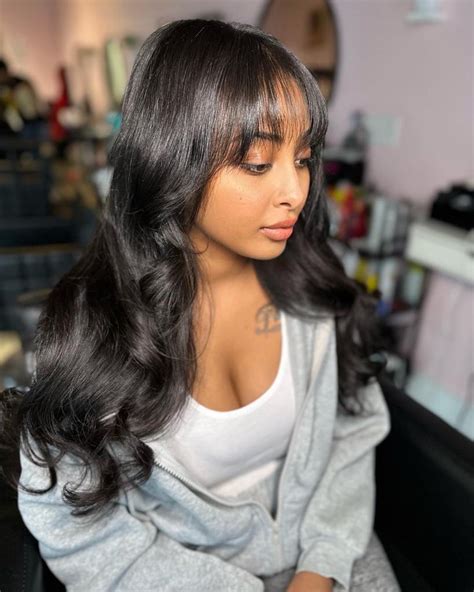Introduction
Hair extensions have become increasingly popular for women looking to add length, volume, or create a dramatic new look. Among the various types of hair extensions available, sew-in extensions offer a versatile and long-lasting option. In this comprehensive guide, we will delve into the world of hair sew-ins, exploring their benefits, drawbacks, types, techniques, and aftercare.

Benefits of Hair Sew-Ins
- Length and Volume: Sew-ins instantly add length and volume to natural hair, allowing you to experiment with different styles and create a fuller, more glamorous look.
- Versatility: Unlike other extension methods, sew-ins can be styled in various ways, including heat styling, coloring, and even curling, without damaging your natural hair.
- Long-Lasting: Sew-in extensions have a longer lifespan compared to other methods, typically lasting for several weeks to months with proper care.
- Protective: Sew-ins can help protect natural hair from heat damage, styling products, and environmental factors by creating a barrier between the hair and external elements.
Drawbacks of Hair Sew-Ins
- Cost: Sew-in extensions can be more expensive than other extension methods, especially if using high-quality human hair.
- Installation Time: The installation process is time-consuming, taking several hours to complete.
- Requires Removal: Sew-ins need to be removed professionally, which can be inconvenient and costly.
- Can Damage Hair: If installed incorrectly or maintained improperly, sew-ins can cause damage to natural hair, leading to breakage or thinning.
Types of Hair Sew-Ins
There are several types of hair sew-ins available, each with its unique characteristics:
- Machine Sew-Ins: These are installed using a sewing machine, creating a fast and precise method.
- Hand Sew-Ins: Requires a skilled technician to hand-stitch the extensions to the natural hair, offering a more natural and seamless look.
- Micro Sew-Ins: Utilizes tiny beads to attach individual strands of extensions to the hair, resulting in a less noticeable and more comfortable fit.
- Clip-In Sew-Ins: Combines the benefits of sew-ins and clip-ins, allowing for temporary extensions that can be easily removed and reattached.
Techniques for Hair Sew-Ins
The technique used for installing sew-in extensions depends on the type chosen. Here are some common techniques:
- Traditional Weave: This involves creating a cornrow or braid near the top of the head and sewing the extensions to the braids.
- Track and Stitch: A track of hair is sewn onto the natural hair using a needle and thread, and extensions are attached to the track.
- Micro-Linking: Tiny metal beads are used to clamp individual strands of extensions to the hair.
- Fusion: Extensions are attached to the hair using heat or glue, creating a strong, long-lasting bond.
Aftercare for Hair Sew-Ins
Proper aftercare is crucial for maintaining the health of your natural hair and ensuring the longevity of the extensions. Here are some tips:
- Wash Regularly: Wash your hair with a sulfate-free shampoo and conditioner, avoiding harsh chemicals.
- Dry Gently: Blot your hair with a towel and air-dry or use a blow dryer on a low heat setting.
- Brush Regularly: Use a wide-toothed comb or brush to prevent tangles and breakage.
- Moisturize: Apply hair oils or serums to keep your natural hair hydrated and prevent dryness.
- Avoid Heat: Use heat styling tools sparingly, and always apply a heat protectant spray before using any heat.
Applications of Hair Sew-Ins
Beyond enhancing the aesthetic appeal of your hair, sew-ins have several practical applications, such as:
- Adding Volume and Length: Sew-ins are an ideal solution for people with thin or fine hair who desire a fuller, more voluminous look.
- Creating Unique Hairstyles: Extensions allow you to experiment with different styles, such as braids, buns, and ponytails, that may not be possible with natural hair alone.
- Protecting Hair: Sew-ins can protect natural hair from environmental factors and heat damage, making them a beneficial option for those who frequently style their hair.
- Fixing Hair Damage: Sew-ins can help disguise damaged or thin sections of hair, allowing you to maintain a healthy and beautiful appearance while your natural hair recovers.
Conclusion
Hair sew-ins are an excellent way to transform the appearance of your hair, adding length, volume, and versatility. By understanding the different types, techniques, and aftercare requirements, you can make informed choices about whether sew-ins are right for you. Whether you’re looking to create a dramatic new look or enhance the beauty of your natural hair, hair sew-ins offer a wide range of options to meet your needs.
Additional Resources
- American Academy of Dermatology: Hair Extensions
- International Association of Professional Hair Stylists: Hair Extensions
- National Hairdressers Federation: Hair Extensions
Tables
Table 1: Comparison of Hair Sew-In Techniques
| Technique | Installation Time | Longevity | Comfort | Damage Risk |
|---|---|---|---|---|
| Machine Sew-Ins | Fast | Moderate | High | Low |
| Hand Sew-Ins | Slow | Long | High | Low |
| Micro Sew-Ins | Slow | Long | Moderate | Low |
| Clip-In Sew-Ins | Moderate | Short | Low | None |
Table 2: Benefits and Drawbacks of Hair Sew-Ins
| Benefits | Drawbacks |
|---|---|
| Length and volume | Cost |
| Versatility | Installation time |
| Long-lasting | Requires removal |
| Protective | Can damage hair |
Table 3: Applications of Hair Sew-Ins
| Application | Solution |
|---|---|
| Adding volume and length | Thin or fine hair |
| Creating unique hairstyles | Limited natural hair styling options |
| Protecting hair | Environmental factors and heat damage |
| Fixing hair damage | Disguise damaged or thin sections |
Table 4: Aftercare Tips for Hair Sew-Ins
| Aftercare Tip | Purpose |
|---|---|
| Wash regularly with sulfate-free shampoo | Remove dirt and oil |
| Dry gently | Prevent breakage and frizz |
| Brush regularly | Detangle and prevent knots |
| Moisturize | Nourish natural hair |
| Avoid heat | Protect hair from heat damage |
